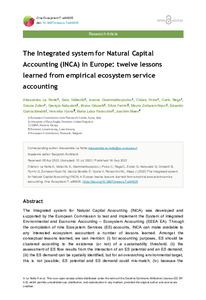| dc.contributor.author | La Notte, A. |
| dc.contributor.author | Vallecillo, S. |
| dc.contributor.author | Grammatikopoulou, L. |
| dc.contributor.author | Polce, C. |
| dc.contributor.author | Rega, C. |
| dc.contributor.author | Zulian, G. |
| dc.contributor.author | Kakoulaki, G. |
| dc.contributor.author | Grizzetti, B. |
| dc.contributor.author | Ferrini, S. |
| dc.contributor.author | Zurbaran-Nucci, M. |
| dc.contributor.author | Bendito, E. |
| dc.contributor.author | Vysna, V. |
| dc.contributor.author | Paracchini, M.L. |
| dc.contributor.author | Maes, J. |
| dc.date.accessioned | 2023-01-04T08:49:07Z |
| dc.date.available | 2023-01-04T08:49:07Z |
| dc.date.issued | 2022-09-16 |
| dc.identifier.citation | La Notte, A., Vallecillo, S., Grammatikopoulou, I., Polce, C., Rega, C., Zulian, G., ... & Maes, J. (2022). The Integrated system for Natural Capital Accounting (INCA) in Europe: twelve lessons learned from empirical ecosystem service accounting. One Ecosystem, 7: e84925, 1-22. |
| dc.identifier.issn | 2367-8194 |
| dc.identifier.uri | https://hdl.handle.net/20.500.12478/7993 |
| dc.description.abstract | The Integrated system for Natural Capital Accounting (INCA) was developed and supported by the European Commission to test and implement the System of integrated Environmental and Economic Accounting – Ecosystem Accounting (SEEA EA). Through the compilation of nine Ecosystem Services (ES) accounts, INCA can make available to any interested ecosystem accountant a number of lessons learned. Amongst the conceptual lessons learned, we can mention: (i) for accounting purposes, ES should be clustered according to the existence (or not) of a sustainability threshold; (ii) the assessment of ES flow results from the interaction of an ES potential and an ES demand; (iii) the ES demand can be spatially identified, but for an overarching environmental target, this is not possible; ES potential and ES demand could mis-match; (iv) because the demand remains unsatisfied; (v) because the ES is used above its sustainability threshold or (vi) because part of the potential flow is missed; (vii) there can be a cause-and-effect relationship between ecosystem condition and ES flow; (viii) ES accounts can complement the SEEA Central Framework accounts without overlapping or double counting. Amongst the methodological lessons learned, we can mention: (ix) already exiting ES assessments do not directly provide ES accounts, but will likely need some additional processing; (x) ES cannot be defined by default as intermediate; (xi) the ES remaining within ecosystems cannot be reported as final; (xii) the assessment and accounting of ES can be undertaken throughout a fast track approach or more demanding modelling procedures. |
| dc.format.extent | 1-22 |
| dc.language.iso | en |
| dc.subject | Ecosystem Services |
| dc.subject | Environment |
| dc.subject | Accounting |
| dc.title | The Integrated system for Natural Capital Accounting (INCA) in Europe: twelve lessons learned from empirical ecosystem service accounting |
| dc.type | Journal Article |
| cg.contributor.affiliation | European Commission Joint Research Centre |
| cg.contributor.affiliation | University of East Anglia |
| cg.contributor.affiliation | International Institute of Tropical Agriculture |
| cg.contributor.affiliation | Eurostat, Luxembourg |
| cg.contributor.affiliation | European Commission |
| cg.coverage.region | ACP |
| cg.coverage.region | Europe |
| cg.coverage.hub | Eastern Africa Hub |
| cg.identifier.bibtexciteid | LANOTTE:2022 |
| cg.authorship.types | CGIAR and advanced research institute |
| cg.iitasubject | Climate Change |
| cg.journal | One Ecosystem |
| cg.notes | Open Access Article; Published online: 16 Sep 2022 |
| cg.accessibilitystatus | Open Access |
| cg.reviewstatus | Peer Review |
| cg.usagerightslicense | Creative Commons Attribution 4.0 (CC BY 0.0) |
| cg.targetaudience | Scientists |
| cg.identifier.doi | https://dx.doi.org/10.3897/oneeco.7.e84925 |
| cg.futureupdate.required | No |
| cg.identifier.issue | e84925 |
| cg.identifier.volume | 7 |

